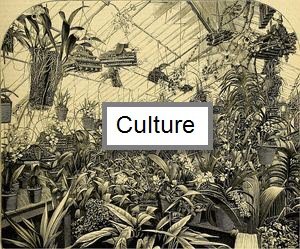We all want to grow healthy and blooming orchids. While growing orchids, I learnt a few tricks. Sometimes, this helped me to avoid and/or remove hurdles such as pests. My research on orchids was run on very meagre monetary support, which egged me on to devise easy, cheap and effective ways to grow healthy orchids.
For the greenhouse, I used a few bamboo poles and transparent plastic sheets. Bamboo was used for setting up the skeleton of the greenhouse. Fix four bamboo poles in the four corners of a square or a rectangle; these would form the four walls. Tie another four horizontal poles on the top the earlier mentioned four corner poles. Around these, the plastic sheets are to be wrapped, but don’t cover the fourth side, as space has to be left for the entrance. For the roof you can fix two somewhat longer bamboo poles in middle of any two opposing sides which are other than the side where you want to keep the entrance. Tie a horizontal pole across the two tall poles also. You can now tie the plastic sheet for the roof on these. You can tie smaller poles in between the structural poles to form the ribs and support the plastic sheets. This will further strengthen the structure and will also prolong the life of the plastic sheet. On the side where you would like to keep the entrance, fix a pole in between the two side poles. Wrap the plastic sheet around the side poles and also cover the pole which was fixed in between leaving out the space for the entrance. The triangular space left between the roof and the sides can also be covered with the plastic sheet.
Inside this orchid house stands can be made for hanging the orchid pots. For orchid stands, fix forked tree stems in the ground and place straight stems/logs in between two forked stems. You can hang your pots and other orchids on the horizontal stem which was placed on the forked stems. Orchids, especially the epiphytes, can be tied to small logs pieces (about a foot long) with the help of coconut husk and rope. Wooden baskets filled with potting media such as moss, tree fern etc. For the terrestrials, you can use small pebbles mixed with activated charcoal/ moss. The whole idea behind the potting mix is moisture retention. There should be free movement of air and water logging should be avoided at all costs. Let your orchid go through dry period in between the watering spells. For the terrestrial, I even used the mud/soil as medium, but took care that extra water has space to leak out at the bottom of the pot.
Watering the orchid should follow a schedule. Once in a week in winters and once or twice daily in summer, depending upon the humidity levels in your area. Keep a higher the watering frequency if the humidity levels are low. To counter dry weather, you can keep container full of water in between your orchids, so that evaporation of this water increases the humidity within the potted area. While watering your orchids, avoid sprinkling water on the parts other than the roots. This is because wetness invites fungal/viral infections. I found the best time to water the orchids was in the morning, when they have whole sunny day ahead to dry off.
Slight care can take your orchids a long way. If you too have some easy tricks which are less pinching to the pocket, then please share them with us.

Greenhouse Construction and Other Tips
Cultureby Anu Dharmani
Originally published in BellaOnline
Posted by Sys Admin almost 9 years ago.Article Blog Article Index
Share on Social Media:
New Topics
- David George asked question Odom's Fascination - an unusual orchid in category General Discussion
- Carol Holdren asked question Grow Tent in the Garage in category General Discussion
- David George asked question rlc Caotan Beauty found at Home Depot in category Cattleya Alliance
- Kristin Dorris asked question Odontocidium Orchid fungus? in category General Discussion
- Maria Fernandez asked question Wild. Lisa Devos in category Dendrobiums
New Comments
- Carol Holdren commented on topic "rlc Caotan Beauty found at Home Depot " by David George
- Carol Holdren commented on topic "Odom's Fascination - an unusual orchid" by David George
- Dr. Florian Wolf commented on topic "Wild. Lisa Devos" by Maria Fernandez
- Michael Valcarcel commented on member plant Rlc. Chief Takanaka by Walceli Muniz Valverde
- Michael Valcarcel commented on member plant Rlc. Montana Spirit by Michael Valcarcel
- Michael Valcarcel commented on member plant Ctt. Blazing Sun by Michael Valcarcel
- Michael Valcarcel commented on member plant Bc. Spotted Clown by Michael Valcarcel
- Maria Skrypnyk commented on member plant Yamadara Redland Sunset by Maria Skrypnyk
- André Pessina commented on topic "Odontocidium Orchid fungus?" by Kristin Dorris
- Linda Hartman commented on topic "Image of a plant please" by Leshya Perkins
- Paul Reavis commented on orchid Milt. Kismet
- Christiaan Viljoen commented on member plant Psh. fragrans by Christiaan Viljoen
- Christiaan Viljoen commented on member plant Z. maculatum by Christiaan Viljoen
- Christiaan Viljoen commented on member plant C. Gaskell-Pumila 'Azure Star' by Christiaan Viljoen
- Robert H. Findlay commented on member plant Rlc. Joy Sokabe var. Volcano Queen by Sally K
- James Lunsford commented on member plant Lc. Sagarik Wax 'African Beauty AMO/AOS x Blc. Cherry Suisse'Kauai' HCC/AOS var. Cattlyea 'Hybrid ' by James Lunsford
- John Varigos commented on orchid Bulb. schwarzii
- Linda Hartman commented on topic "Issue with Blc. Ben O'Neil "Jubilee" by Glenda Ratliff
- Henry Shaw commented on member plant Ons. Catatante 'Los Roble' by Henry Shaw
- Mary Lane commented on member plant Den. Tianmu Canary by Terre Moore